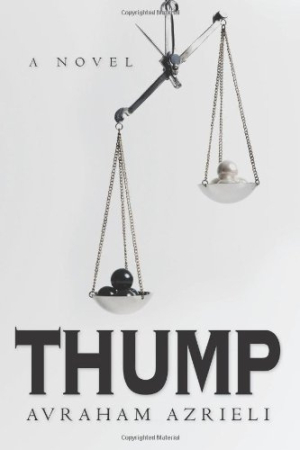Thump
Racial and sexual tension in the workplace combine in a stimulating, suspenseful novel.
Emeritus lawyer Avraham Azrieli deviates from the realm of political thrillers to deliver a taut courtroom drama that blends issues of race and sexual harassment. Focusing on the ethical questions circling the firing of a promising young executive, Thump’s various bold personalities collide over socially fraught questions with stimulating results.
The novel opens to find Thurgood Marshall Jefferson, or “Thump,” in his fifth year at the investment firm KKG, and rising quickly in its ranks. Outwardly, he’s a picture of success, right down to his recent engagement to nurse Tiffany. But beneath the veneer of his daily life, Thump grapples with the near constant effects of sexual harassment. His mentor, firm partner Henrietta Kingman, perpetuates the situation, preying upon him herself but also pimping him out to a number of wealthy female clients. Lines such as “his large, black hand rested on her feminine white hand” delineate social strata neatly, if without delicacy. When Thump scorns Henrietta, she exacts her revenge, which leads to his dismissal. These events are detailed convincingly, and their nonlinear presentation deepens the novel’s suspense.
The latter portions of the novel follow the resultant court case. Thump engages the services of former judge Ruth O’Connor, a lawyer looking for redemption after racially charged remarks forced her to relinquish her bench. Her brash courtroom manner draws ethical questions to the fore, with shocking and piquing results.
Though the counsel for the defendant works hard to convince jurors that KKG was in the right, Thump’s moral high ground is never in real question. The eventual verdict is a requisite answer to the drawn-out question of whether employees, particularly black male employees, are really the masters of their own sexual agency.
Thump treads the same ground that Michael Crichton’s Disclosure covered decades ago, though with questions of race brought in, often compellingly. Unfortunately, its characters sometimes become painful caricatures in this respect.
Henrietta and the other abusers are given to addressing Thump as “boy.” Thump’s mother, presented as an empowering maternal figure, runs a home presided over by an ostentatious oil painting of Martin Luther King, Jr. Meanwhile, O’Connor, though educated and accomplished, utters phrases like “white people know that a black man, statistically speaking, is much more likely to be dangerous” without blinking, and engages in victim-blaming on issues of rape, but maintains throughout that she’s not racist. The hubris of each character may ring true, but frequent evasions of redemption become a point of frustration.
Blunt dialogue, a quick pace, and pressing social questions make Thump an engrossing read, if it sometimes fails to provide satisfactory answers to its own questions. The novel covers important ground, though at times without befitting subtlety.
Reviewed by
Michelle Anne Schingler
Disclosure: This article is not an endorsement, but a review. The publisher of this book provided free copies of the book and paid a small fee to have their book reviewed by a professional reviewer. Foreword Reviews and Clarion Reviews make no guarantee that the publisher will receive a positive review. Foreword Magazine, Inc. is disclosing this in accordance with the Federal Trade Commission’s 16 CFR, Part 255.

